Radio86RK - Soviet homemade computer
Have you ever collected a computer? Well, at least once in my life. At least not completely.
- “Well, of course!” - you will say.
And you will not quite right.
')
No, I do not detract from your achievements at all, however, back in 1986, only experienced radio amateurs could assemble a computer in the USSR. It is now enough to buy a motherboard, a processor, get a couple of slats of RAM and a larger hard drive, and put it all in a beautiful case with a power supply unit for 500W. All this, mind you, is done without the help of a soldering iron, oscilloscope and a heap of schematic diagrams.
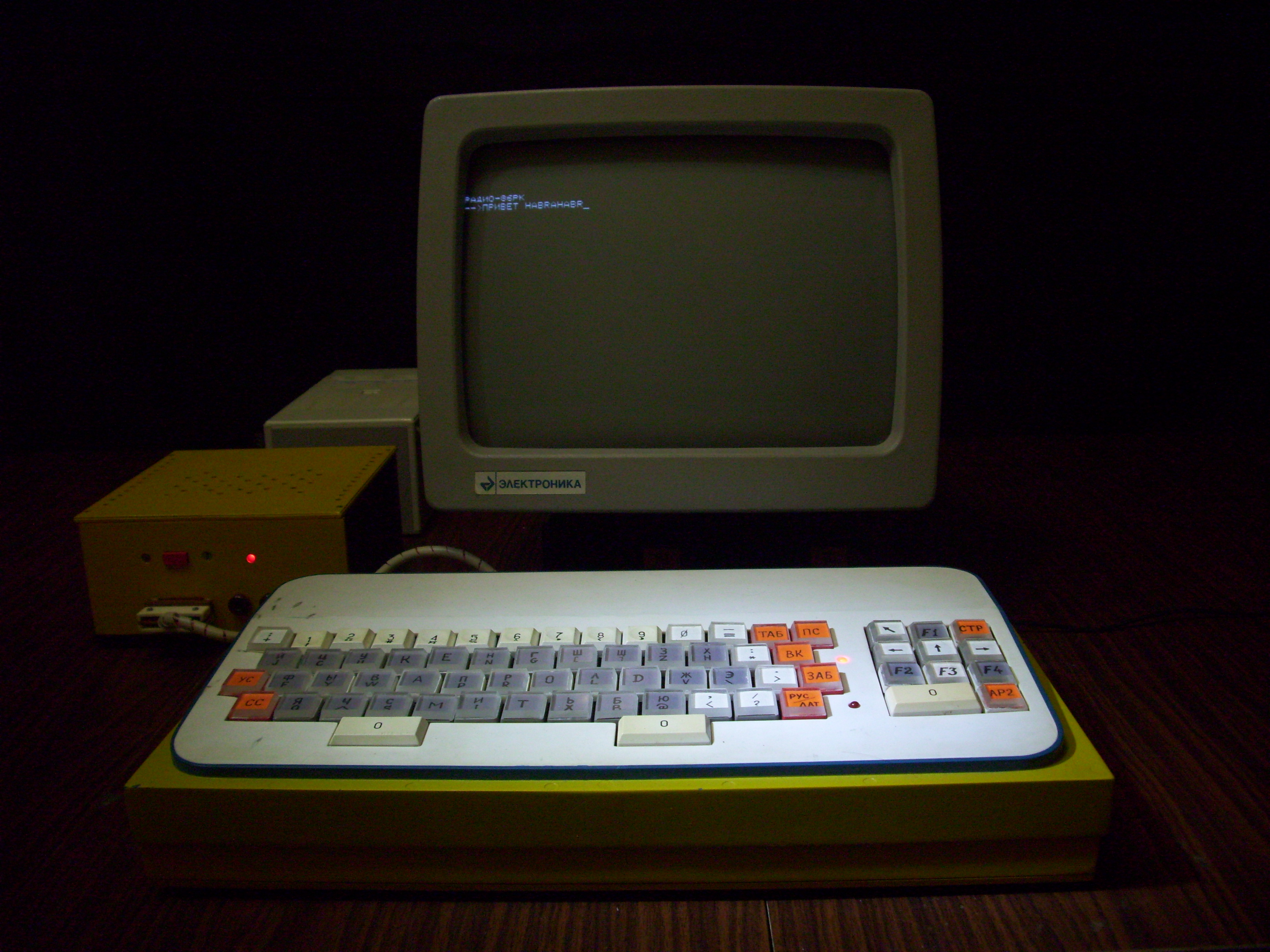
Only a few readers of Habr can boast that in Soviet times they really collected household computers. We used honest and dishonest ways to get scarce chips, etched out printed circuit boards, fought UV ROM until nighttime, armed with a toggle programmer, or wound transformers for power supplies. After several months of painstaking assembly and adjustment, it finally turned out that we can proudly be called a household computer. And if you managed to find or make a suitable and beautiful case for your creation, then such a computer caused envy to all who had not yet pumped their craft skills to level 80.
Radio86RK became one of the most popular self-made household computers, the description and scheme of which were published in a series of articles in Radio magazine No. 4-6 / 1986. Two authors of these articles, G. Zelenko and S. Popov, in collaboration with V. AT. Panov, subsequently released the book "Home Computer" (Publishing House "Radio and Communication"), entirely devoted to the computer Radio86RK.
Radio86RK is not the first consumer computer that was proposed for assembly by radio amateurs. Its predecessor was the "Micro-80", which consisted of a large number of modules, and had about 200 microcircuits. It was difficult to assemble and adjust, so it did not get much spread.

One of the authors of the computer "Micro-80". The image is taken from the site http://mrsaing.my1.ru
But Radio86RK consisted of only 29 chips and a small number of other radio components, was simple to assemble and, if no errors were made in the installation, began to work immediately after turning on the power. However, due to falling into defective radio components, Radio86RK could not start up, and that was when you had to pick up the oscilloscope probes and look for a malfunction.
Only later, when the state decided to produce amateur radio designers (and even produce clones of amateur radio household computers) serially, it became a little easier for radio amateurs to live.
One of the clones of Radio86RK, which was mass-produced in production, was already written on Habré in the review of the Mikrosha PC, one of the clones of Radio-86RK , but the author refused to work correctly at this home computer because of the consumed capacitors KM, which, because of the precious metals contained in them, at one time, apparently, they passed in tsvetmet.

Microsha. Image taken from wikipedia.org
In addition, “Microsha” is only partially compatible with its progenitor, so many programs and games for Radio86RK will not be able to run on it without an appropriate adaptation.
In addition to Mikroshi, the Habr pages were reviewed by the Orion-128 radio amateur computer , which, apparently, was based on Radio86RK. Orion-128 had much more RAM than Radio86RK, a ROM disk and a disk drive were connected to it, it was also possible to connect a hard disk up to 10Mb through a special controller.
But so far no one has written a review about the parent of all these numerous clones, namely about Radio86RK. Today I would like to correct this unfortunate misunderstanding. So, let's begin.
Technical characteristics Radio86RK.

Processor: K580IK80A (KR580VM80A) - the Soviet analogue of the processor I8080A, operating at a frequency of 1.78 MHz. In fact, the nominal clock frequency of this processor was 2.5 MHz, however, to simplify the design of the home computer Radio86, it was decided to abandon the clock generator for the video controller, and use the processor clock generator as it. Due to the fact that the video controller digested only the frequency of 1.78 MHz, it was necessary to be content with an underestimated frequency of the processor.

ROM: 2 KB on a microcircuit with ultraviolet erasure K573RF2 or K573RF5 (bourgeois analogue - 2716) in which is placed the control program "Monitor". During the debugging of the computer, instead of the “Monitor”, a diagnostic test was recorded in the ROM, checking the correct operation of the memory, character generator and keyboard. Therefore, this chip is usually installed on the socket.

RAM: in the original version - 16 KB on eight K565RU3 microcircuits. In the modified version - 32KB on sixteen K565RU6 microcircuits (soldered to each other on the second floor). For the normal operation of the computer Radio86RK with 32 KB of RAM, it was necessary to change the firmware of the Monitor's ROM in connection with the change of the final RAM addresses.

Video subsystem: built on a bundle of KR580VG75 + KR580VT57 chips. Symbols for the character generator are stitched in a K573RF1 ROM chip. This chip required for its power as much as three voltages: +5, +12 and -5 volts, and often failed if one of the supply voltages was lost. Many radio amateurs replaced it with a K573RF5 microcircuit, the benefit of which changes were made to small ones. Only the text black-and-white mode of 25 lines by 64 characters is available, despite the fact that the KR580VG75 microcircuit made it possible to realize a color image. For simplicity of design, they decided to abandon the color image.
Due to the scarcity of the KR580VG75 microcircuit, some radio amateurs replaced it with a separate fee containing about twenty more common microcircuits. True, after such a replacement, programs that accessed video memory directly, in particular games, did not work correctly on the computer. Without adaptation, only those programs that accessed the video memory through the functions of the ROM worked.
As a monitor, a conventional TV or video monitor Electronics MS 6105 was used.

The keyboard was a matrix with contacts for a short circuit, which was fully serviced by the CPU through an I / O port, made on one of the KR580BB55 chips (there are two such chips in the computer). In the keyboard, reed buttons were most often used from calculators, which did not differ in smoothness, but had high reliability.

The source of the sound was the output of the INTE processor (on which the “interrupt enable” signal was formed), switched by EI / DI commands. Since no interrupts were used on the computer, this output was free. Do not lose the good, right?

Power supply: one of the most important components of the computer, designed with the highest possible reliability, because due to its malfunction, rather scarce and expensive chips could fail. The fact is that for its operation the computer Radio86RK used three supply voltages (-5V, + 5V and + 12V), and the voltage -5V should be the first to be supplied, and then + 5V and + 12V. They should be removed in the reverse order. Also allowed the simultaneous filing and removal of all the voltage, and the disappearance of one of them should be removed and all the rest.

As an external device for the storage of programs and data was used household tape recorder.

Peripheral devices (for example, a printer) were connected to a free port on the second KR580VB55 chip.
Appearance Radio86RK.
Talking about the appearance of a homemade computer is not entirely correct.
Everyone tried as best he could, and made a corps under his PK86 from what came to hand. Some did not bother at all, and left the computer without a body at all, and then holili and cherished it - God forbid you throw tea on it, or kill it with static.
Radio amateurs who have comprehended Zen, tried to hide their offspring in the corps from the Soviet calculators of appropriate dimensions (for example, Iskra 111M ), and those people who could not only hold a soldering iron in their hands, but also work with plexiglass to make their own enclosures.
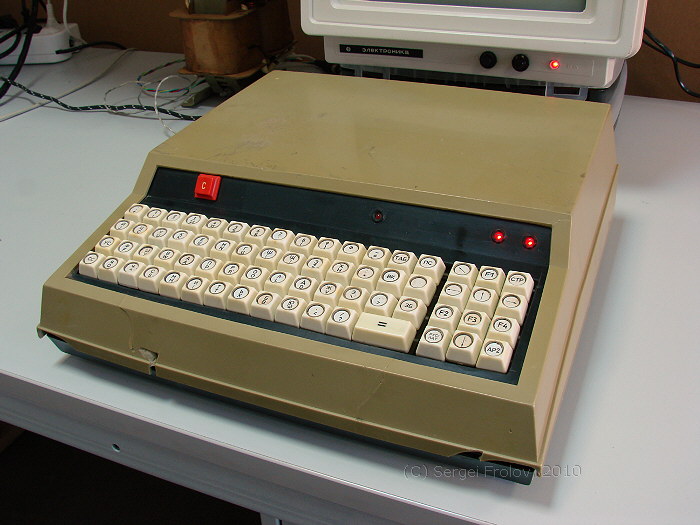
Radio86RK in the case of the Spark 111M calculator. Image taken from http://sfrolov.livejournal.com
And now, let's look at the corpus version of my copy of Radio86RK.
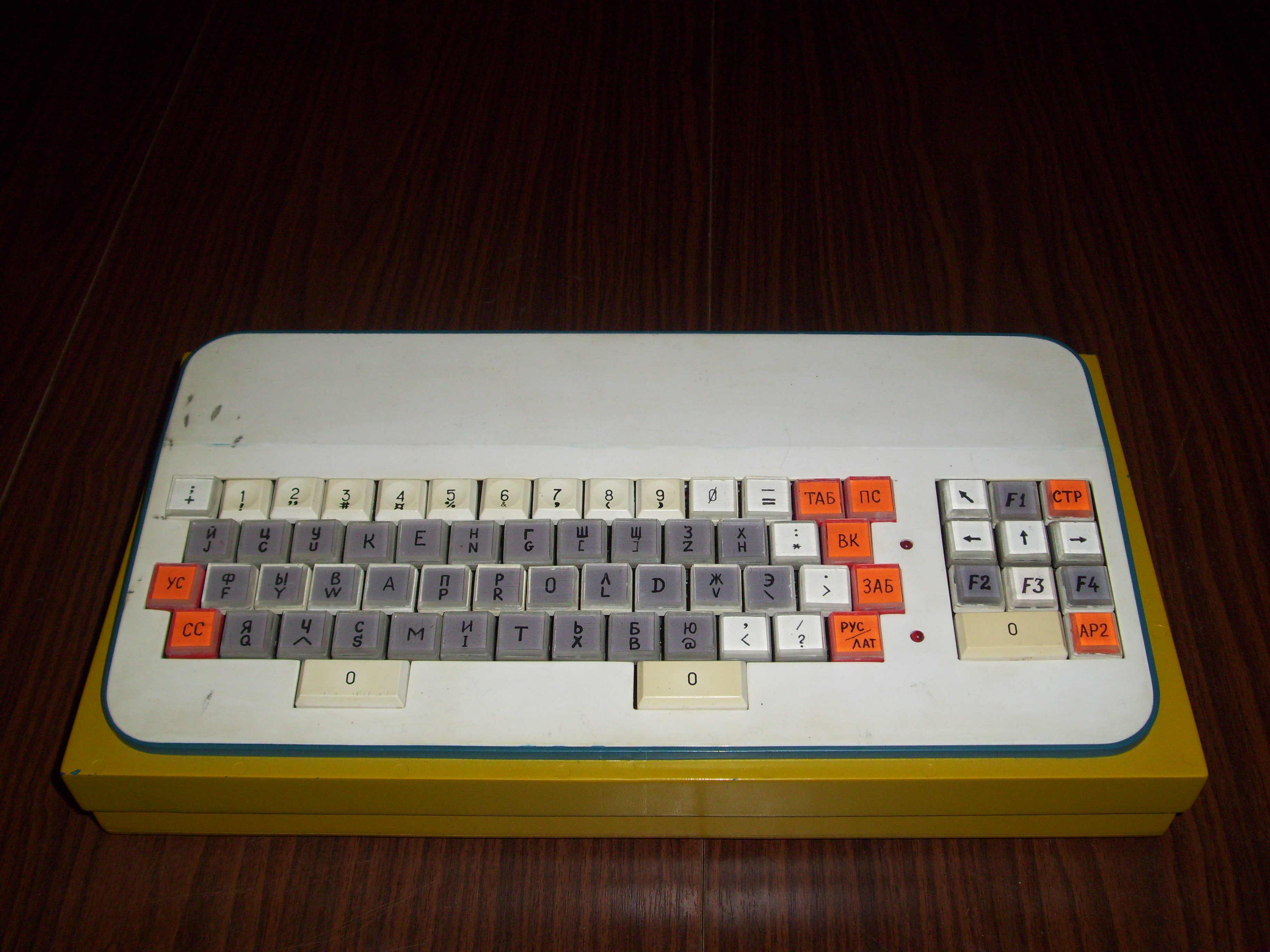
It is made of plexiglass, and is colored yellow. In the top cover of the case, holes for buttons and two LEDs are cut out.
The keyboard is typed from buttons from the Soviet calculators. Letters and arrows had to be drawn on the buttons manually - on top of such buttons there are transparent caps that protect the label from erasing. The numbers on the buttons were not necessary to draw, since they had already been applied in the factory to the buttons of each self-respecting calculator.
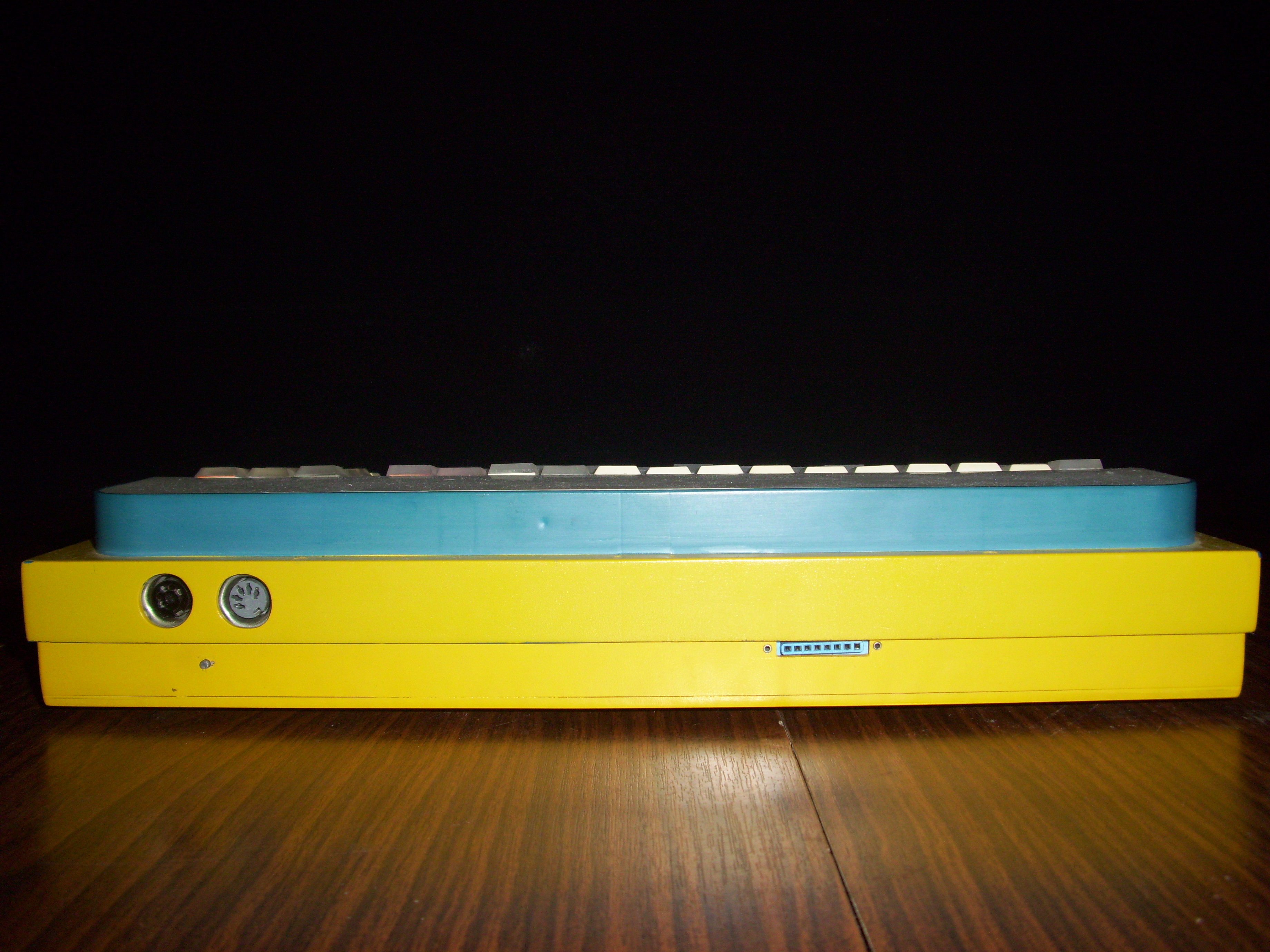
On the sides of the case there is nothing interesting, but on the back there are all the necessary connectors - a connector for connecting a tape recorder, a TV set, a “Reset” button, and a connector for the power supply.
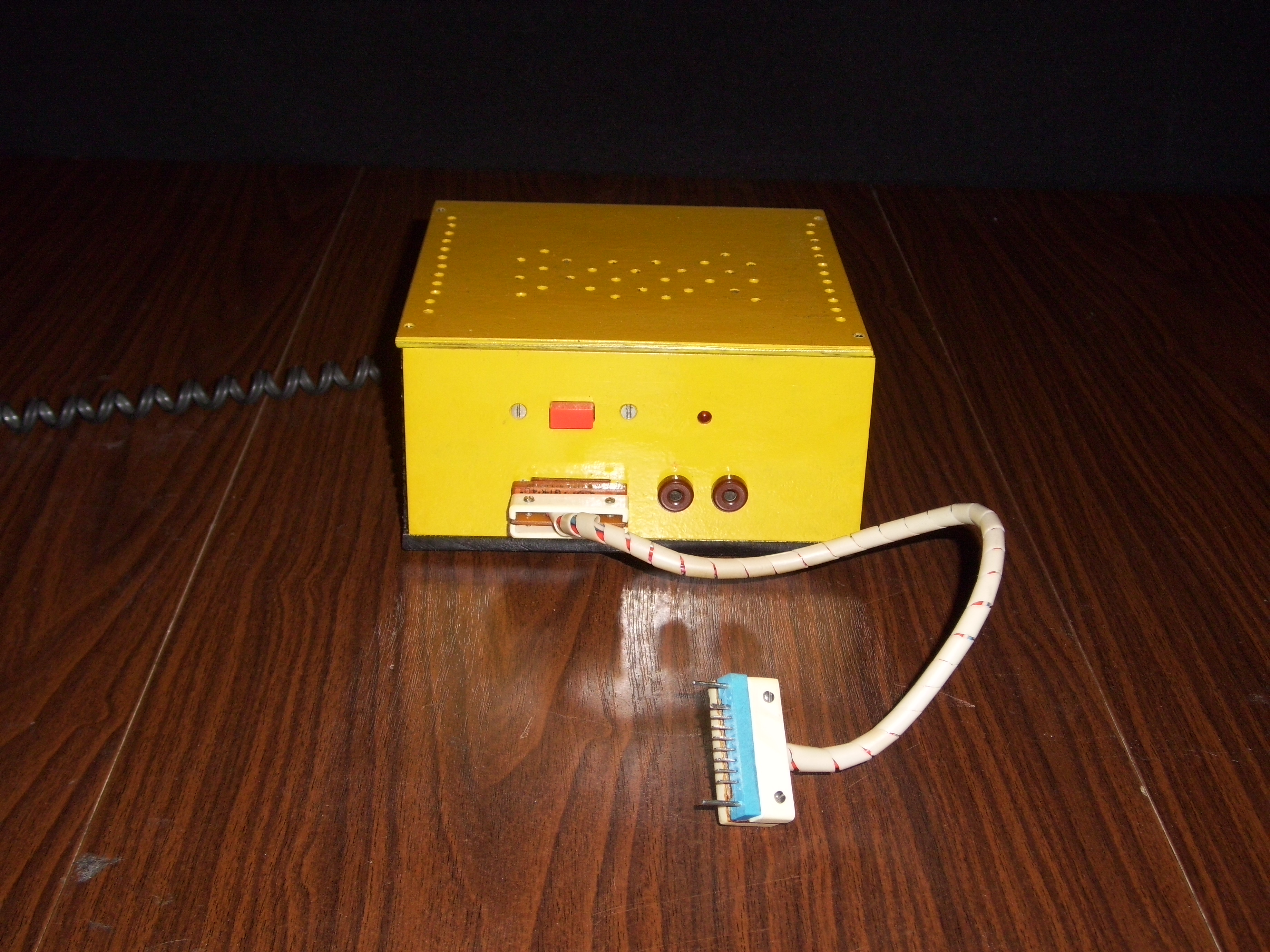
The power supply case is also made of plexiglass and painted yellow.
In addition to the Radio86RK power connector and the power button, there is a + 5V socket on the front side of the PSU case, which, in principle, is not needed. But this is not a bug, this is a feature (s).
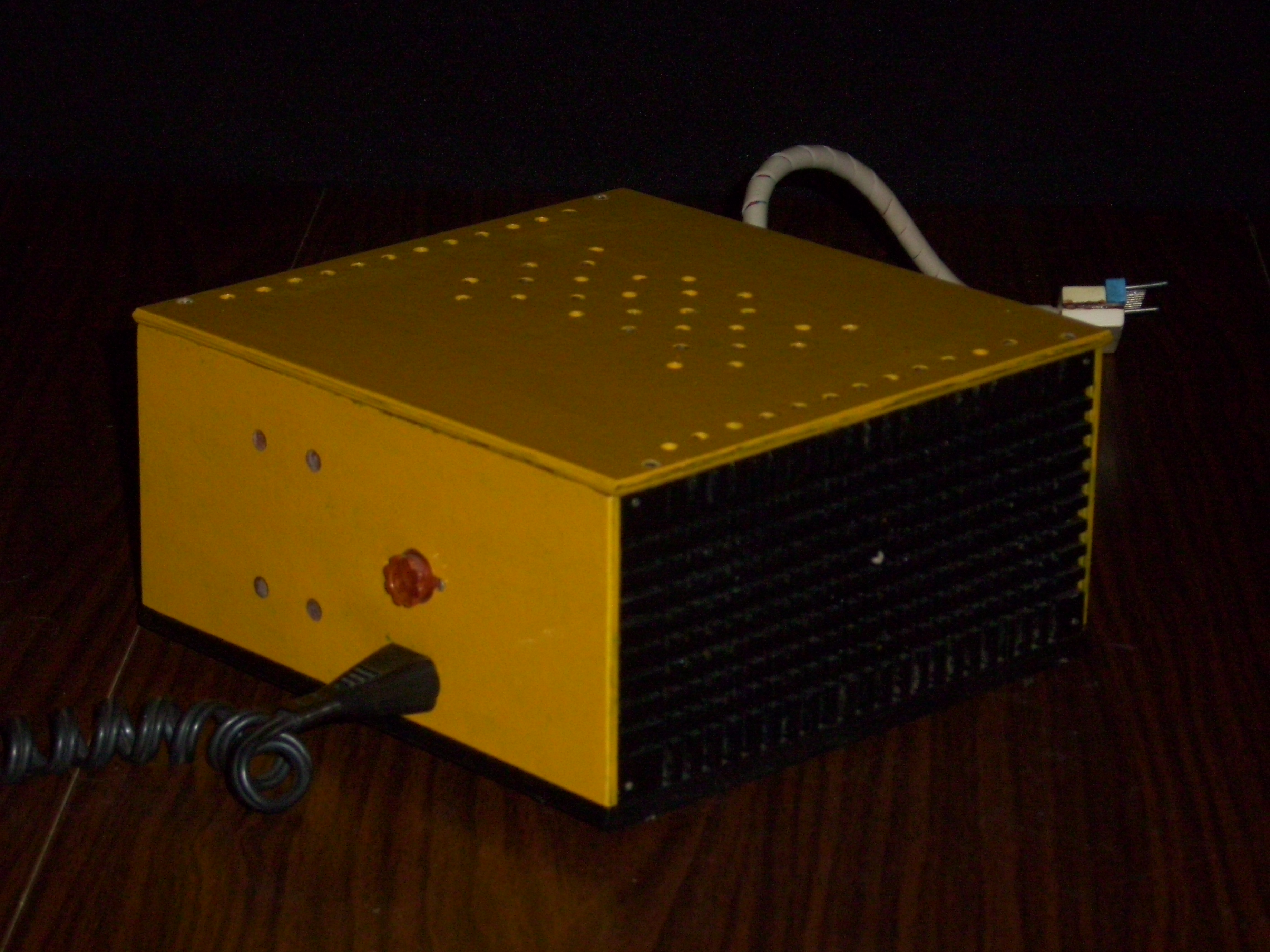
The side wall of the power supply - a giant radiator. This is how cooling problems were solved.
What's inside it?

Remove the upper part of the case - no screws, just pull up.
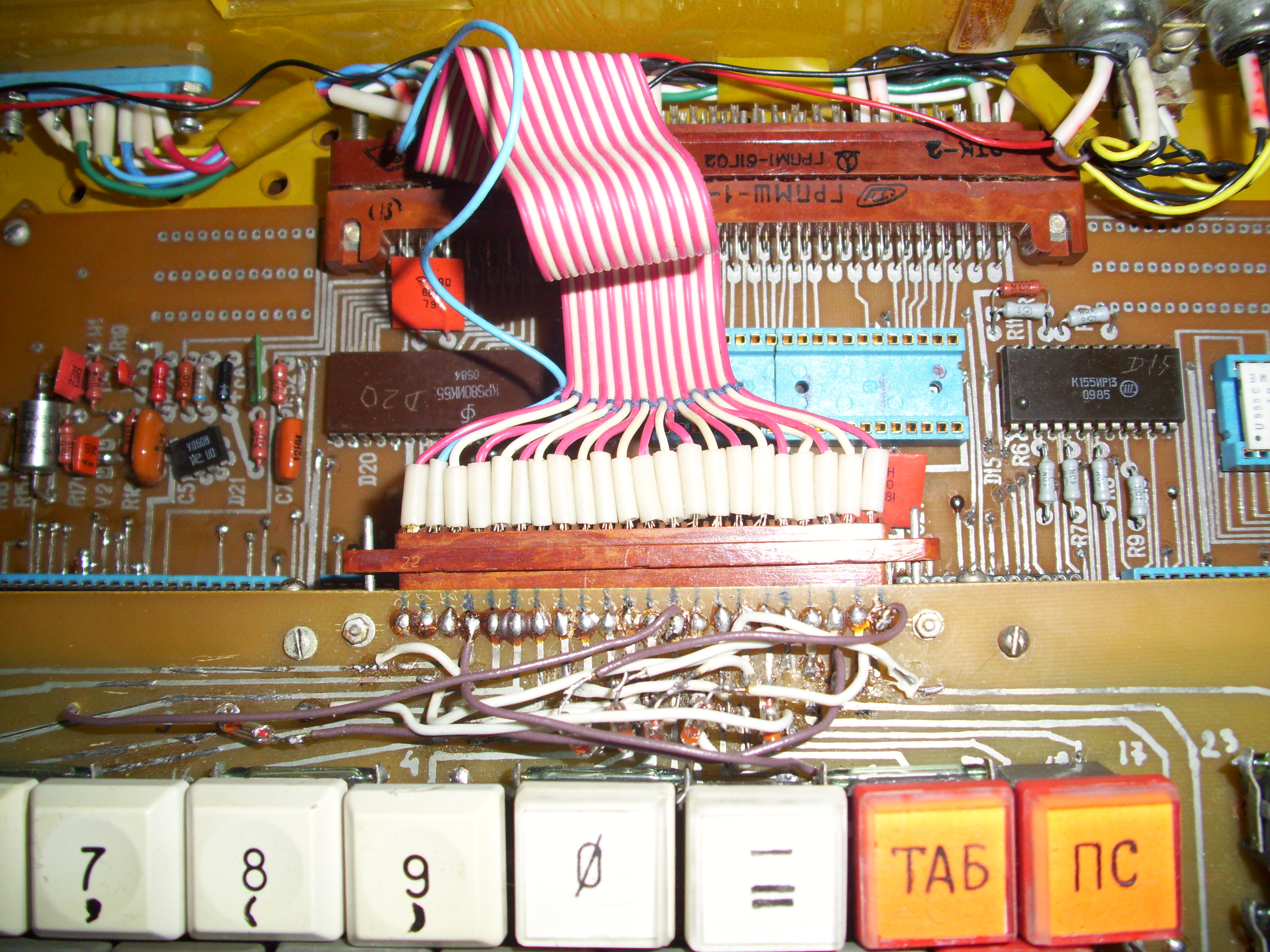
Our eyes appear keyboard connected to the main circuit board of the computer cable.
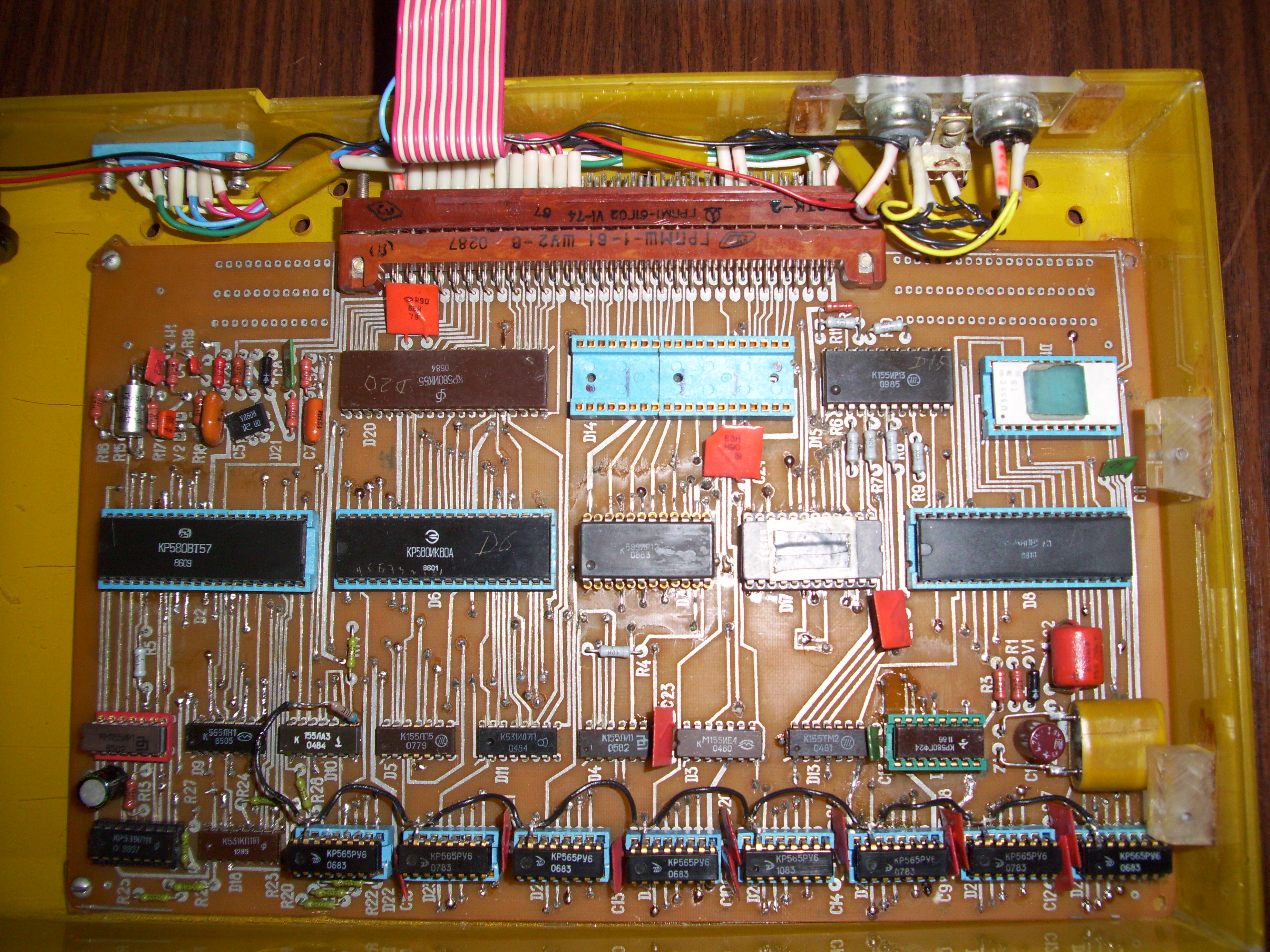
By unscrewing the 4 screws and unplugging the cable from the keyboard, you can get to the main board of the Radio86RK computer. The printed circuit board is two-sided, rather qualitatively etched. However, due to wiring errors, some of the tracks were cut and laid using ordinary wire.
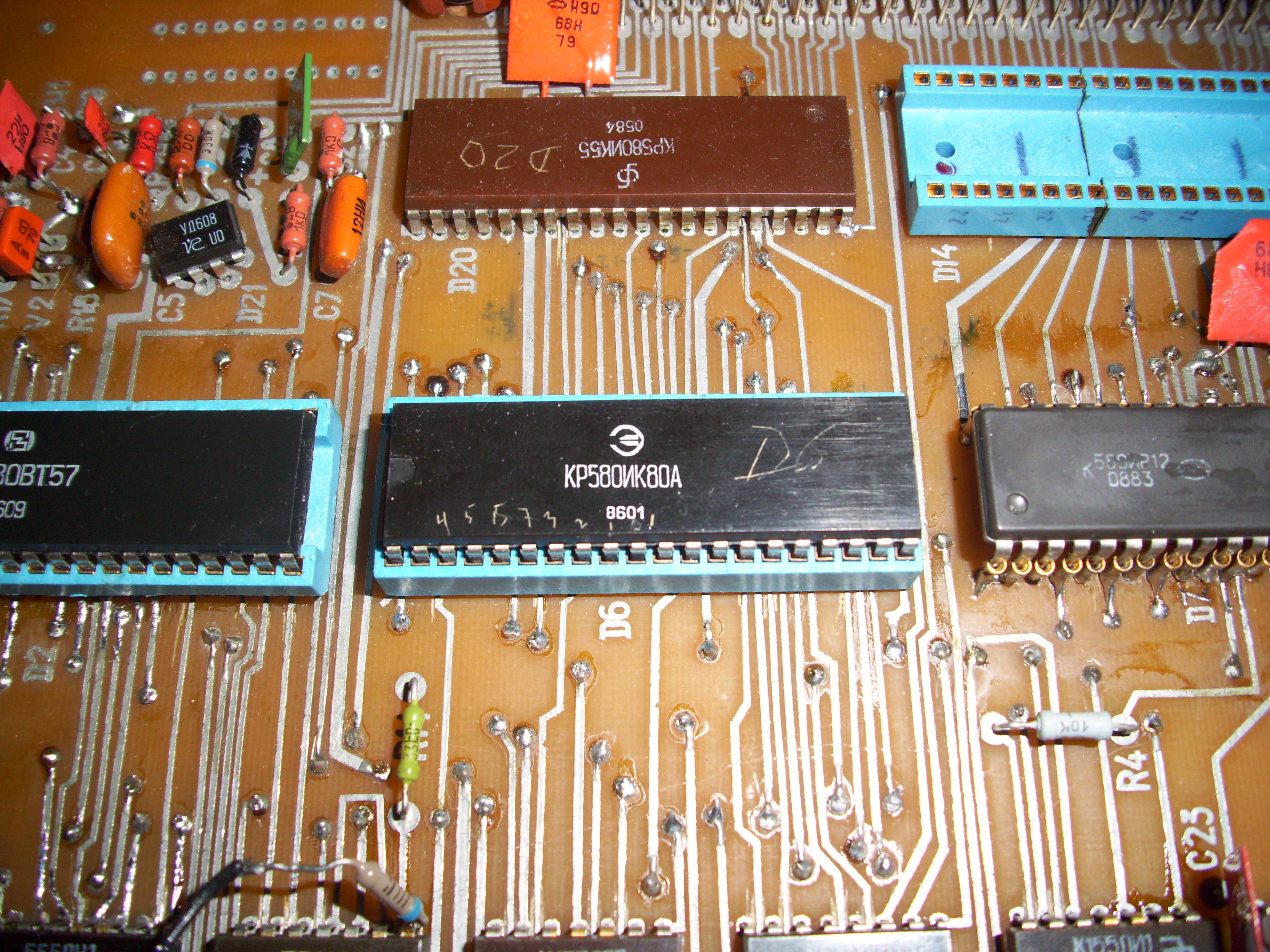
A lot of chips installed on the panel. For example, the processor.

RAM is also nested in the panels. Yes, and the second floor.
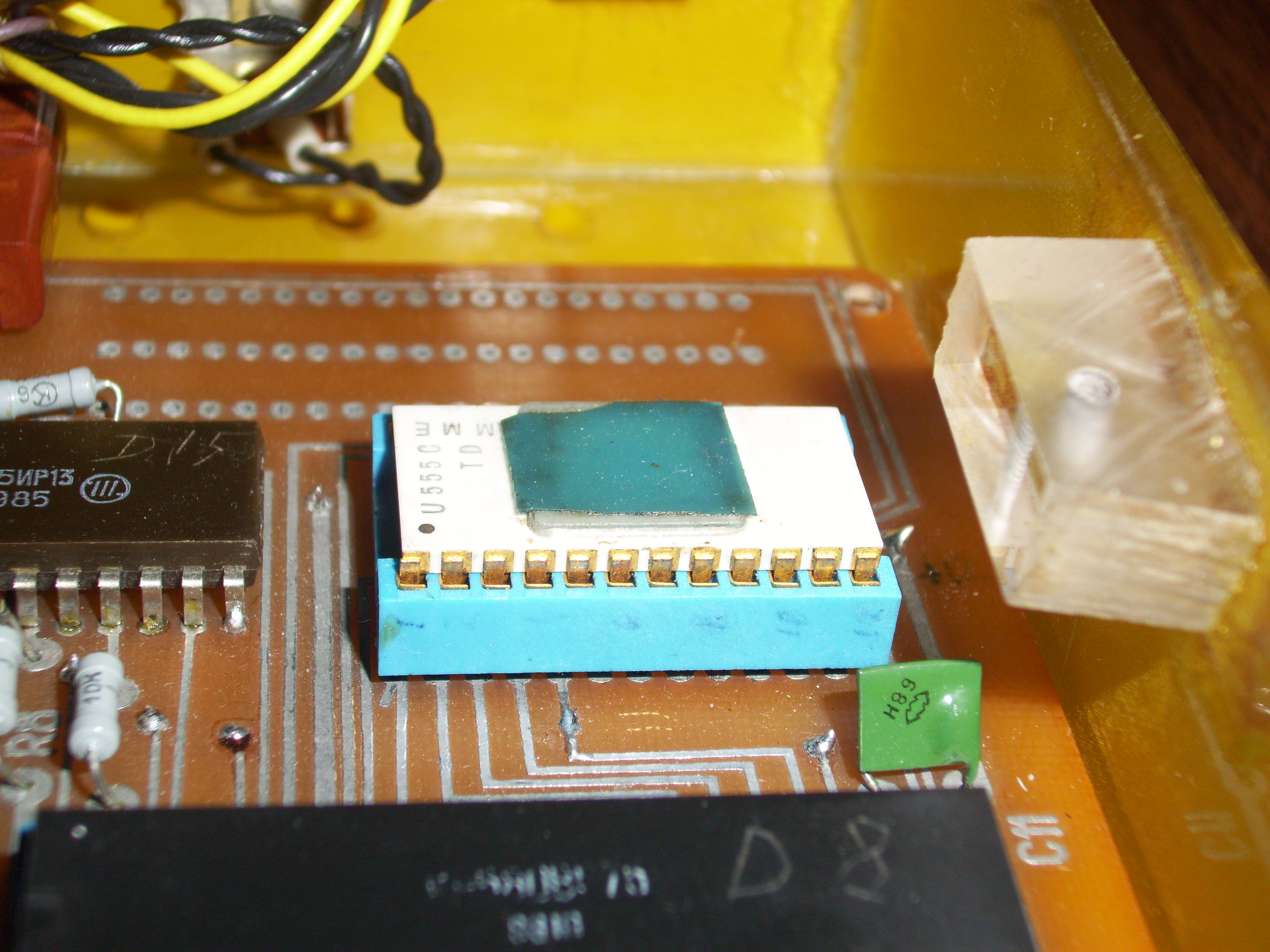
Sign generator. Instead of the domestic chip K573RF1, it is made on the German equivalent of the U555. So safer.
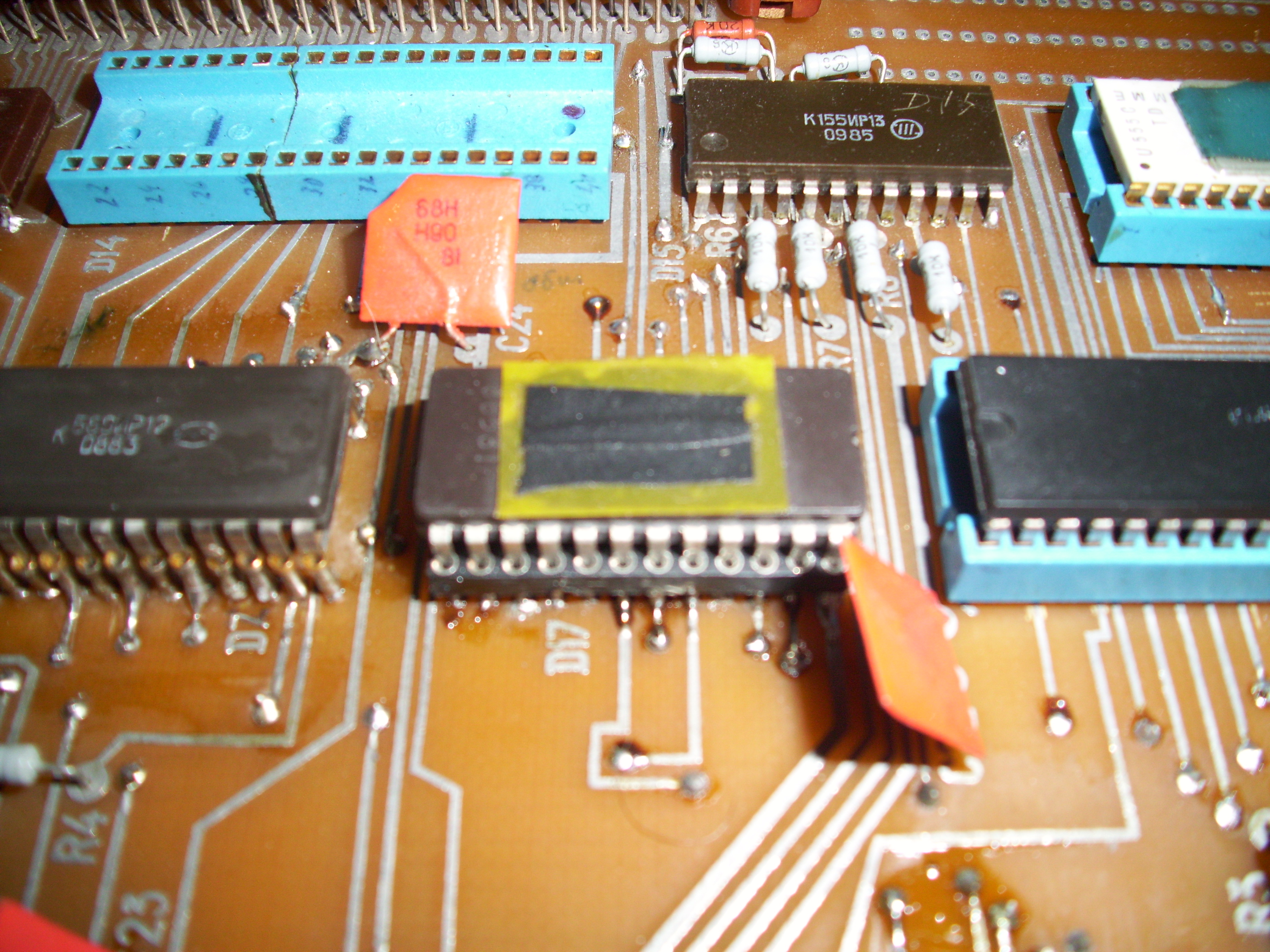
Chip K573RF5 (ROM "Monitor") is also replaced by a similar chip 2716.

Clock generator KR580GF24. Also in the socket.

Keyboard I / O port. Nearby there is an empty socket for the same microcircuit designed for connecting 8-bit peripheral devices.
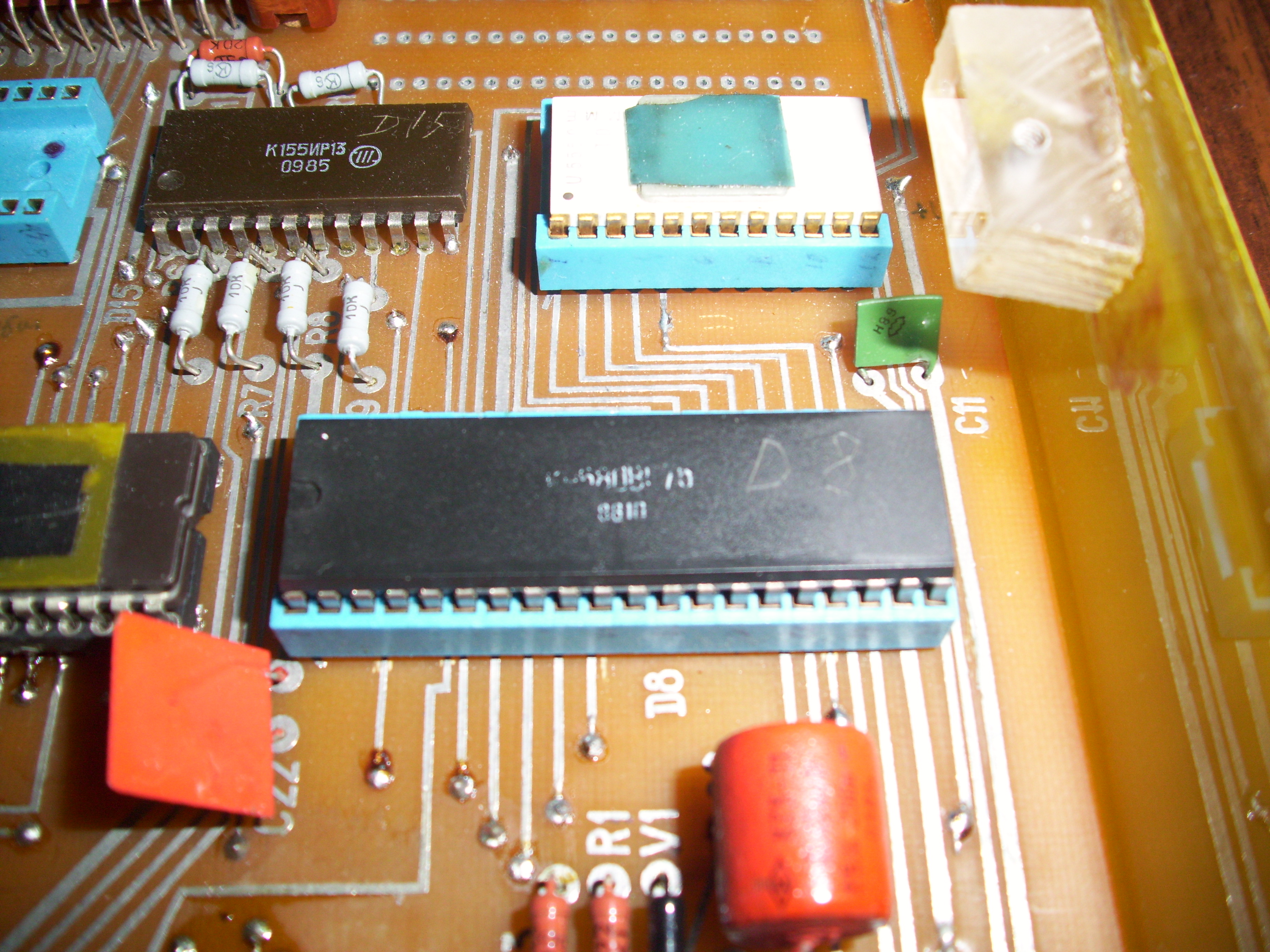
Video controller
I remind you that a radio amateur should collect all this beauty himself, guided by the description and diagrams from the Radio magazine. And to help in the painstaking assembly and adjustment should have reference tables, published there.

It looked like this.
Cause time, fun - an hour.
Many will probably be interested in what the tough guys played, who managed to assemble the household computer Radio86RK. It turns out that quite a decent number of programs were written for PK86, including entertaining ones.
Want to look at them? You are welcome!
First connect Radio86 to the monitor and tape recorder. Now we insert the cassette with your favorite game, press the I button on the computer (the initial letter of the word “Input”), after it, do not forget to press the VC key (carriage return, similar to the Enter key), and turn on the tape recorder for playback. The monitor magically stops displaying anything on the screen (this is a feature of the computer), and only after loading the program does the image reappear. Loading is complete.
To start the program, you must press the G button (the initial letter of the word "GO"), and confirm the command by pressing the VK key. Sometimes it is necessary to specify the starting memory address where the program is located, but this happens very rarely.
Let's see what you could play on the computer Radio86RK.
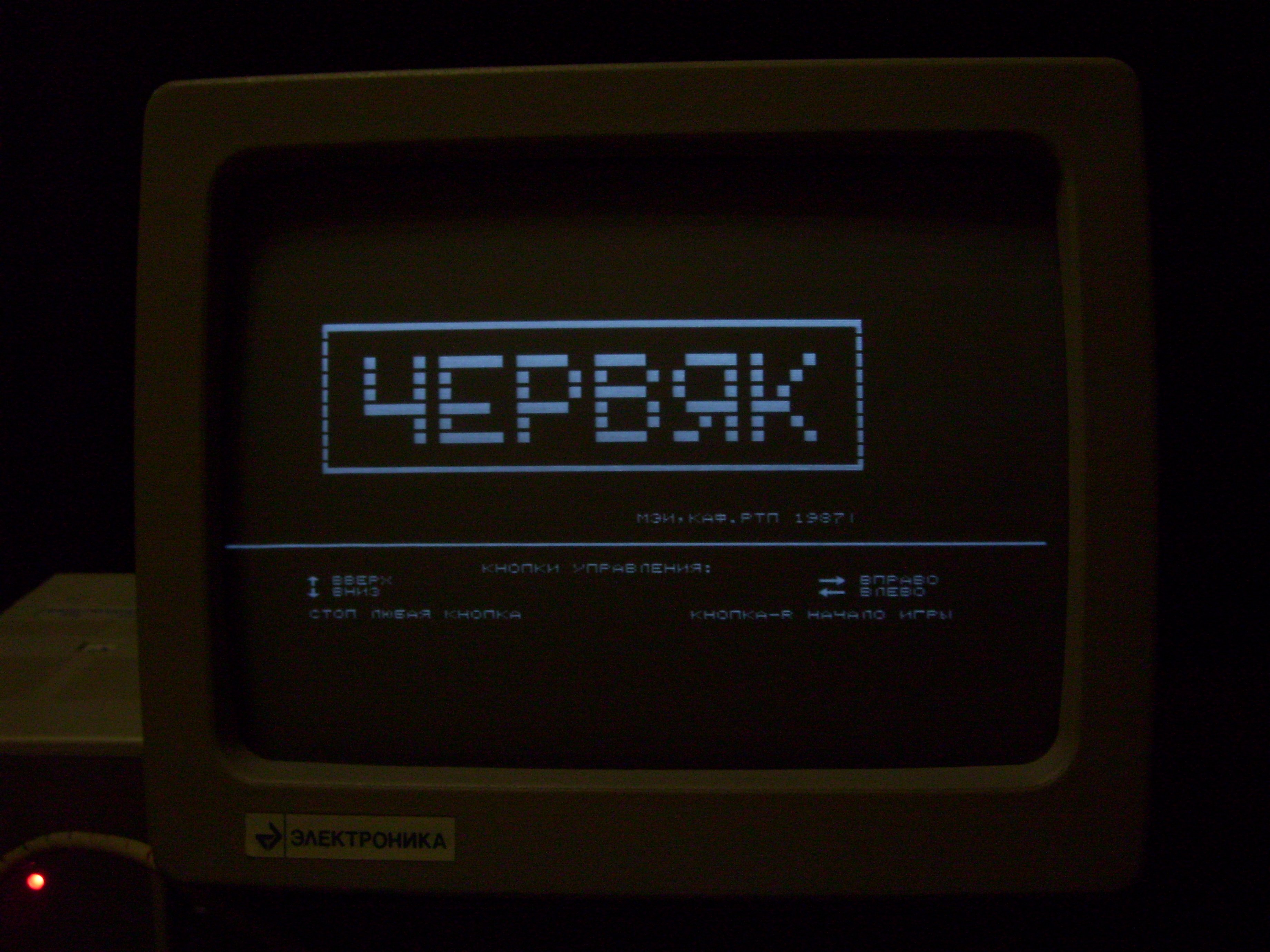
Worm.
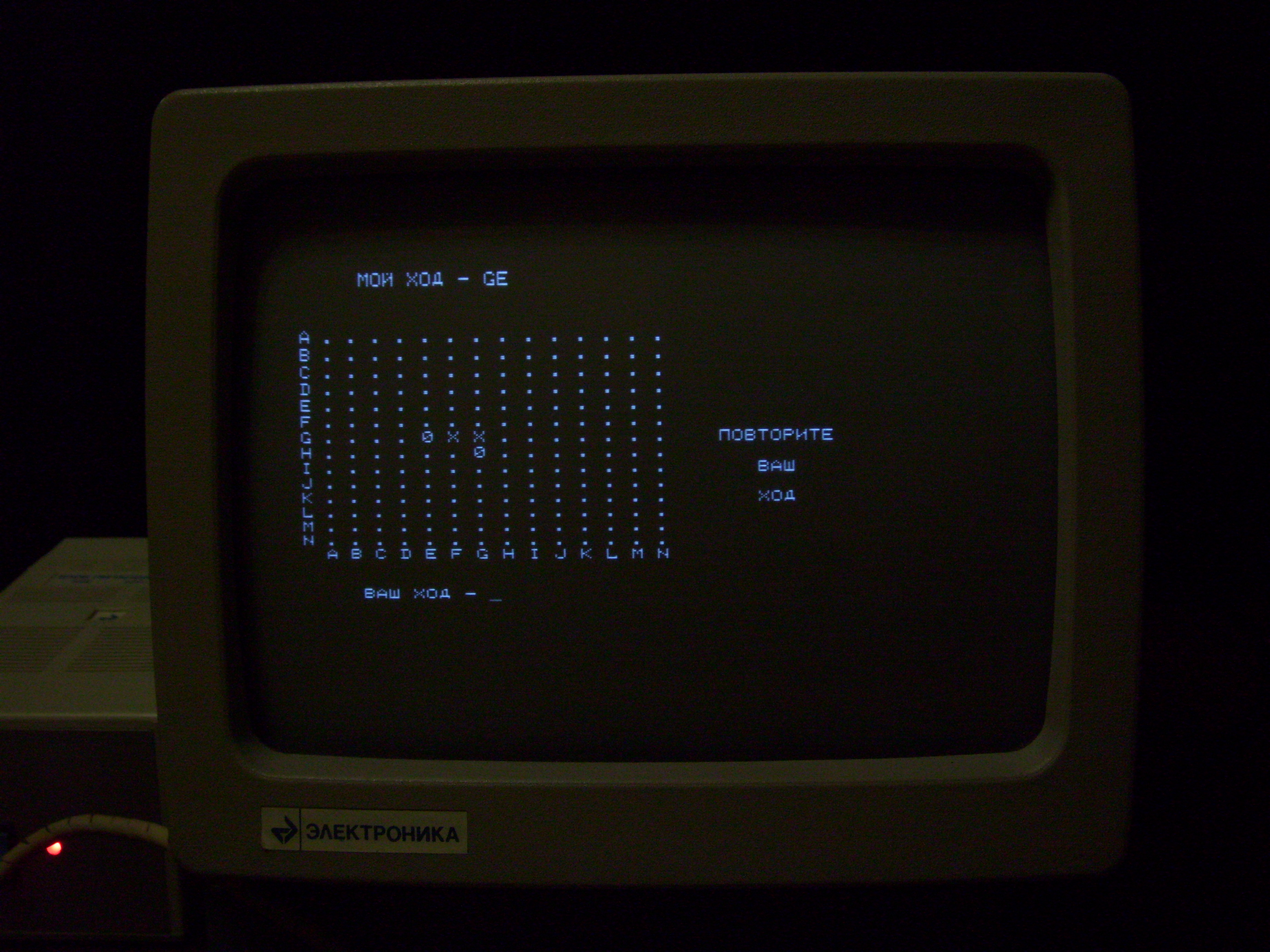
Tic tac toe

Circus

Lode runner

Pacman
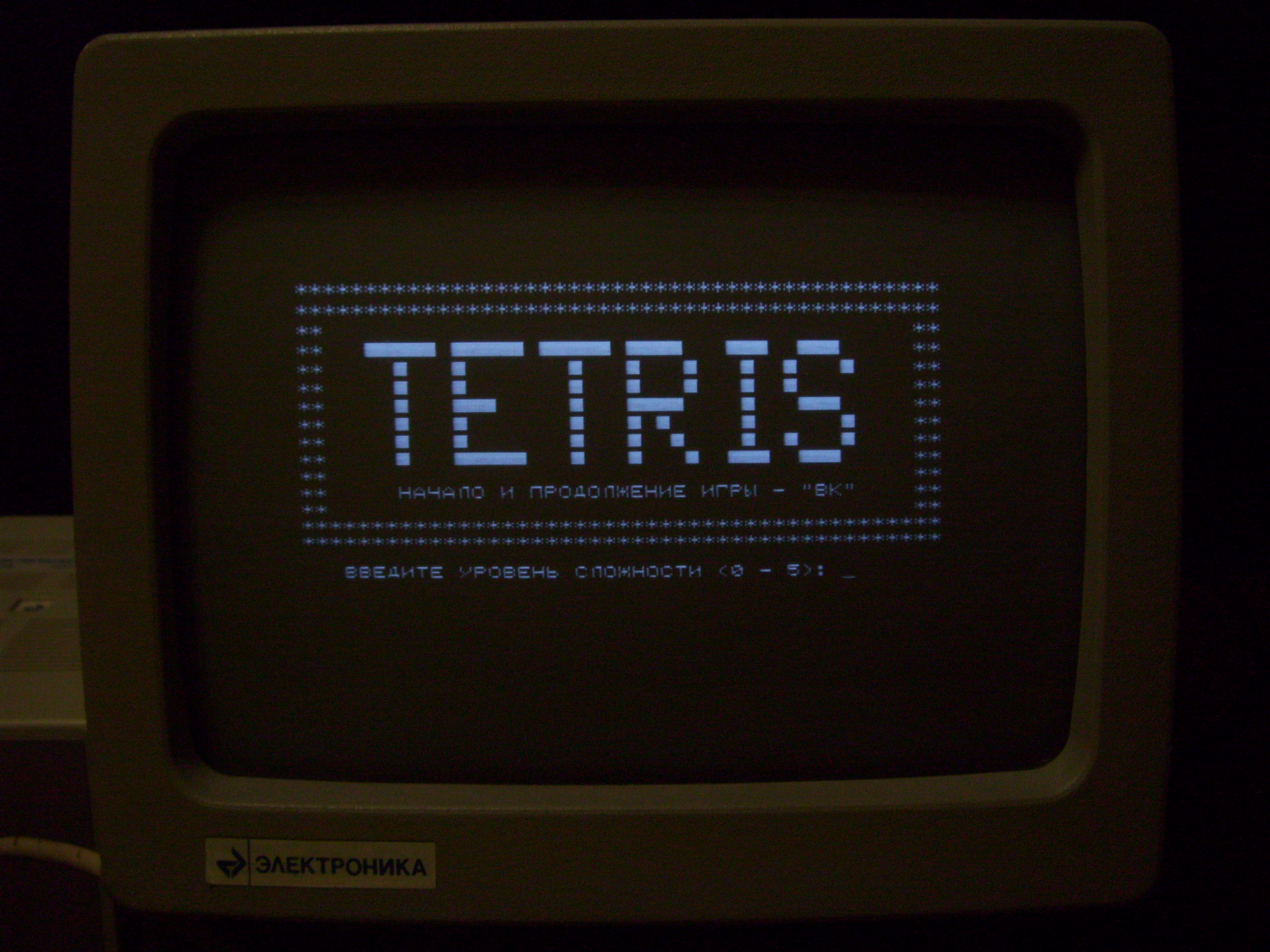
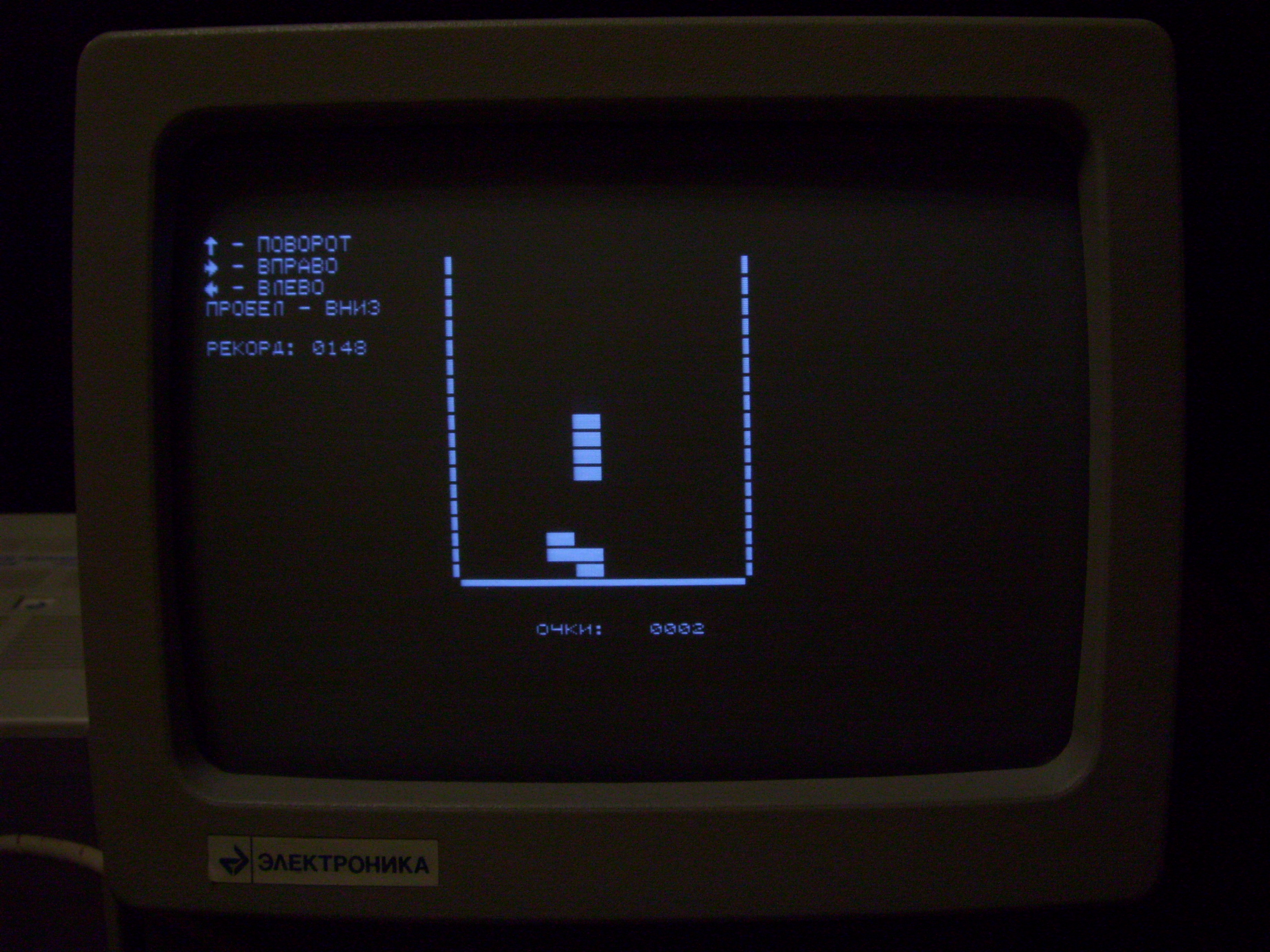
Tetris
Conclusion
That is, in principle, all that I wanted to tell about the Soviet self-made household computer Radio86RK. Perhaps someone from Habr's readers at one time was engaged in assembling such a computer, or worked on it. If you can share your impressions, comments and just interesting facts about Radio86RK, I will be grateful to you.
- “Well, of course!” - you will say.
And you will not quite right.
')
No, I do not detract from your achievements at all, however, back in 1986, only experienced radio amateurs could assemble a computer in the USSR. It is now enough to buy a motherboard, a processor, get a couple of slats of RAM and a larger hard drive, and put it all in a beautiful case with a power supply unit for 500W. All this, mind you, is done without the help of a soldering iron, oscilloscope and a heap of schematic diagrams.

Only a few readers of Habr can boast that in Soviet times they really collected household computers. We used honest and dishonest ways to get scarce chips, etched out printed circuit boards, fought UV ROM until nighttime, armed with a toggle programmer, or wound transformers for power supplies. After several months of painstaking assembly and adjustment, it finally turned out that we can proudly be called a household computer. And if you managed to find or make a suitable and beautiful case for your creation, then such a computer caused envy to all who had not yet pumped their craft skills to level 80.
Radio86RK became one of the most popular self-made household computers, the description and scheme of which were published in a series of articles in Radio magazine No. 4-6 / 1986. Two authors of these articles, G. Zelenko and S. Popov, in collaboration with V. AT. Panov, subsequently released the book "Home Computer" (Publishing House "Radio and Communication"), entirely devoted to the computer Radio86RK.
Radio86RK is not the first consumer computer that was proposed for assembly by radio amateurs. Its predecessor was the "Micro-80", which consisted of a large number of modules, and had about 200 microcircuits. It was difficult to assemble and adjust, so it did not get much spread.

One of the authors of the computer "Micro-80". The image is taken from the site http://mrsaing.my1.ru
But Radio86RK consisted of only 29 chips and a small number of other radio components, was simple to assemble and, if no errors were made in the installation, began to work immediately after turning on the power. However, due to falling into defective radio components, Radio86RK could not start up, and that was when you had to pick up the oscilloscope probes and look for a malfunction.
Only later, when the state decided to produce amateur radio designers (and even produce clones of amateur radio household computers) serially, it became a little easier for radio amateurs to live.
One of the clones of Radio86RK, which was mass-produced in production, was already written on Habré in the review of the Mikrosha PC, one of the clones of Radio-86RK , but the author refused to work correctly at this home computer because of the consumed capacitors KM, which, because of the precious metals contained in them, at one time, apparently, they passed in tsvetmet.

Microsha. Image taken from wikipedia.org
In addition, “Microsha” is only partially compatible with its progenitor, so many programs and games for Radio86RK will not be able to run on it without an appropriate adaptation.
In addition to Mikroshi, the Habr pages were reviewed by the Orion-128 radio amateur computer , which, apparently, was based on Radio86RK. Orion-128 had much more RAM than Radio86RK, a ROM disk and a disk drive were connected to it, it was also possible to connect a hard disk up to 10Mb through a special controller.
But so far no one has written a review about the parent of all these numerous clones, namely about Radio86RK. Today I would like to correct this unfortunate misunderstanding. So, let's begin.
Technical characteristics Radio86RK.

Processor: K580IK80A (KR580VM80A) - the Soviet analogue of the processor I8080A, operating at a frequency of 1.78 MHz. In fact, the nominal clock frequency of this processor was 2.5 MHz, however, to simplify the design of the home computer Radio86, it was decided to abandon the clock generator for the video controller, and use the processor clock generator as it. Due to the fact that the video controller digested only the frequency of 1.78 MHz, it was necessary to be content with an underestimated frequency of the processor.

ROM: 2 KB on a microcircuit with ultraviolet erasure K573RF2 or K573RF5 (bourgeois analogue - 2716) in which is placed the control program "Monitor". During the debugging of the computer, instead of the “Monitor”, a diagnostic test was recorded in the ROM, checking the correct operation of the memory, character generator and keyboard. Therefore, this chip is usually installed on the socket.

RAM: in the original version - 16 KB on eight K565RU3 microcircuits. In the modified version - 32KB on sixteen K565RU6 microcircuits (soldered to each other on the second floor). For the normal operation of the computer Radio86RK with 32 KB of RAM, it was necessary to change the firmware of the Monitor's ROM in connection with the change of the final RAM addresses.

Video subsystem: built on a bundle of KR580VG75 + KR580VT57 chips. Symbols for the character generator are stitched in a K573RF1 ROM chip. This chip required for its power as much as three voltages: +5, +12 and -5 volts, and often failed if one of the supply voltages was lost. Many radio amateurs replaced it with a K573RF5 microcircuit, the benefit of which changes were made to small ones. Only the text black-and-white mode of 25 lines by 64 characters is available, despite the fact that the KR580VG75 microcircuit made it possible to realize a color image. For simplicity of design, they decided to abandon the color image.
Due to the scarcity of the KR580VG75 microcircuit, some radio amateurs replaced it with a separate fee containing about twenty more common microcircuits. True, after such a replacement, programs that accessed video memory directly, in particular games, did not work correctly on the computer. Without adaptation, only those programs that accessed the video memory through the functions of the ROM worked.
As a monitor, a conventional TV or video monitor Electronics MS 6105 was used.

The keyboard was a matrix with contacts for a short circuit, which was fully serviced by the CPU through an I / O port, made on one of the KR580BB55 chips (there are two such chips in the computer). In the keyboard, reed buttons were most often used from calculators, which did not differ in smoothness, but had high reliability.

The source of the sound was the output of the INTE processor (on which the “interrupt enable” signal was formed), switched by EI / DI commands. Since no interrupts were used on the computer, this output was free. Do not lose the good, right?

Power supply: one of the most important components of the computer, designed with the highest possible reliability, because due to its malfunction, rather scarce and expensive chips could fail. The fact is that for its operation the computer Radio86RK used three supply voltages (-5V, + 5V and + 12V), and the voltage -5V should be the first to be supplied, and then + 5V and + 12V. They should be removed in the reverse order. Also allowed the simultaneous filing and removal of all the voltage, and the disappearance of one of them should be removed and all the rest.

As an external device for the storage of programs and data was used household tape recorder.

Peripheral devices (for example, a printer) were connected to a free port on the second KR580VB55 chip.
Appearance Radio86RK.
Talking about the appearance of a homemade computer is not entirely correct.
Everyone tried as best he could, and made a corps under his PK86 from what came to hand. Some did not bother at all, and left the computer without a body at all, and then holili and cherished it - God forbid you throw tea on it, or kill it with static.
Radio amateurs who have comprehended Zen, tried to hide their offspring in the corps from the Soviet calculators of appropriate dimensions (for example, Iskra 111M ), and those people who could not only hold a soldering iron in their hands, but also work with plexiglass to make their own enclosures.

Radio86RK in the case of the Spark 111M calculator. Image taken from http://sfrolov.livejournal.com
And now, let's look at the corpus version of my copy of Radio86RK.

It is made of plexiglass, and is colored yellow. In the top cover of the case, holes for buttons and two LEDs are cut out.
The keyboard is typed from buttons from the Soviet calculators. Letters and arrows had to be drawn on the buttons manually - on top of such buttons there are transparent caps that protect the label from erasing. The numbers on the buttons were not necessary to draw, since they had already been applied in the factory to the buttons of each self-respecting calculator.

On the sides of the case there is nothing interesting, but on the back there are all the necessary connectors - a connector for connecting a tape recorder, a TV set, a “Reset” button, and a connector for the power supply.

The power supply case is also made of plexiglass and painted yellow.
In addition to the Radio86RK power connector and the power button, there is a + 5V socket on the front side of the PSU case, which, in principle, is not needed. But this is not a bug, this is a feature (s).

The side wall of the power supply - a giant radiator. This is how cooling problems were solved.
What's inside it?

Remove the upper part of the case - no screws, just pull up.

Our eyes appear keyboard connected to the main circuit board of the computer cable.

By unscrewing the 4 screws and unplugging the cable from the keyboard, you can get to the main board of the Radio86RK computer. The printed circuit board is two-sided, rather qualitatively etched. However, due to wiring errors, some of the tracks were cut and laid using ordinary wire.

A lot of chips installed on the panel. For example, the processor.

RAM is also nested in the panels. Yes, and the second floor.

Sign generator. Instead of the domestic chip K573RF1, it is made on the German equivalent of the U555. So safer.

Chip K573RF5 (ROM "Monitor") is also replaced by a similar chip 2716.

Clock generator KR580GF24. Also in the socket.

Keyboard I / O port. Nearby there is an empty socket for the same microcircuit designed for connecting 8-bit peripheral devices.

Video controller
I remind you that a radio amateur should collect all this beauty himself, guided by the description and diagrams from the Radio magazine. And to help in the painstaking assembly and adjustment should have reference tables, published there.

It looked like this.
Cause time, fun - an hour.
Many will probably be interested in what the tough guys played, who managed to assemble the household computer Radio86RK. It turns out that quite a decent number of programs were written for PK86, including entertaining ones.
Want to look at them? You are welcome!
First connect Radio86 to the monitor and tape recorder. Now we insert the cassette with your favorite game, press the I button on the computer (the initial letter of the word “Input”), after it, do not forget to press the VC key (carriage return, similar to the Enter key), and turn on the tape recorder for playback. The monitor magically stops displaying anything on the screen (this is a feature of the computer), and only after loading the program does the image reappear. Loading is complete.
To start the program, you must press the G button (the initial letter of the word "GO"), and confirm the command by pressing the VK key. Sometimes it is necessary to specify the starting memory address where the program is located, but this happens very rarely.
Let's see what you could play on the computer Radio86RK.

Worm.

Tic tac toe

Circus

Lode runner

Pacman


Tetris
Conclusion
That is, in principle, all that I wanted to tell about the Soviet self-made household computer Radio86RK. Perhaps someone from Habr's readers at one time was engaged in assembling such a computer, or worked on it. If you can share your impressions, comments and just interesting facts about Radio86RK, I will be grateful to you.
Source: https://habr.com/ru/post/172405/
All Articles